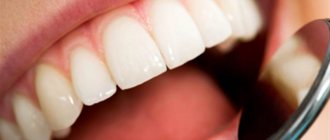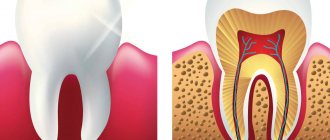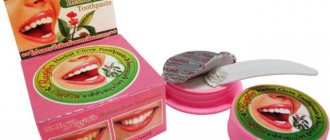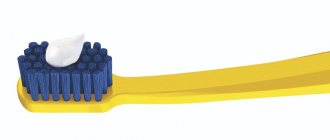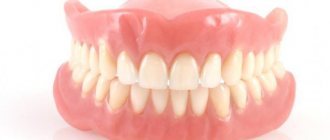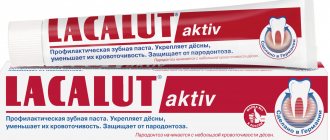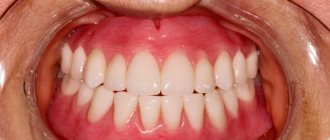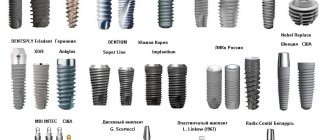Dental deposits are plaque and tartar that form on the surfaces of teeth and accumulate in the supragingival and subgingival space. Dental plaque not only makes our teeth unsightly - dull and yellow, but they contribute to the development of a wide variety of dental diseases of the teeth and gums. It is for this reason that it is imperative to remove dental plaque and do it in the dentist’s office, using professional techniques and equipment.
How dental plaque is removed in dentistry, by what methods and what is the price for the service in Moscow - we will answer all these questions in detail in this article.
What are dental deposits?
Such formations on the teeth appear even in those who regularly and conscientiously brush their teeth and take care of their oral cavity. Deposits on teeth are formed under the influence of various factors. They affect not only the crown of the tooth, but also the surface of the gums. Dental deposits often cause the development of diseases of the gums and teeth. They are irritating to the gums and tooth enamel, as they contain a huge amount of bacteria and their metabolic products. Partially, soft plaque is removed when brushing your teeth. But this is only provided that the oral cavity is cleaned correctly and regularly. If personal hygiene rules are not followed, plaque remains on the teeth, between them and gradually leads to the formation of hard deposits.
Mechanism of formation of tartar
The causes of tartar are as follows: after eating food, particles remain in the mouth. They act as a favorable environment for the proliferation of pathogenic bacteria. They give greater preference to easily digestible carbohydrates: particles of sweet food, baked goods. Experts have found that even one day of lack of hygiene doubles the amount of bacterial plaque in the mouth.
Nutrients are used by microorganisms for more than just reproduction. They also secrete special enzymes - enzymes, which allow them to firmly attach to the surface of the tooth enamel. Lack of hygiene leads to the fact that individual pinpoint colonies quickly merge into one “plaque”, forming an impressive mass of plaque. Before it begins to mineralize, it can be easily brushed off with a toothbrush.
With the gradual mineralization of soft deposits, stone formation occurs. Calcification occurs as follows: calcium salts, which are part of saliva, settle on the soft plaque. Mineralization is accompanied by the process of layering of new and new colonies of bacteria, which leads to an increase in the volume of solid deposits.
The mechanism of tartar formation is accompanied by processes such as the release of toxic substances and inflammatory mediators by plaque. This becomes the cause of inflammatory processes in soft tissues. Symptoms of this complication are:
- bleeding of the gums - due to mechanical stress, and in severe cases, spontaneous;
- redness, cyanosis, swelling of the gums;
- soreness, itching;
- the appearance of pus in periodontal pockets;
- mobility of individual teeth.
Inflammation contributes to an even greater increase in the number of bacteria. In the place where the gums adhere to the surface of the tooth there is a periodontal groove, into which liquid with salts and proteins is produced from the gums. This leads to the growth of bacterial colonies. With inflammation, this fluid becomes larger, resulting in an environment for reproduction that is even more favorable for microorganisms. Calcification occurs even faster.
Types of dental plaque
- Dental plaque is a soft deposit that gradually accumulates on teeth, fillings, and dentures. It is formed from food residues and waste products of bacteria. This deposit is firmly fixed on the teeth and can only be removed by physical methods;
- soft clusters resemble a thick mass of white-yellow color. Also formed by bacteria, their waste products, saliva and food debris;
- leftover food.
Mineralized deposits. These include tartar. It can be supragingival and subgingival. It has a dense structure and dark color. There are several factors that contribute to the formation of dental plaque:
- content in the diet of too soft food;
- disruption of metabolic processes in the body;
- preference to chew on only one side;
- malocclusion.
Tartar is formed, as a rule, in places where there is bad impact during brushing and self-cleaning does not occur.
After the removal procedure
After removing hard deposits, the doctor must polish the teeth - plaque accumulates more slowly on a smooth surface. Also, to consolidate the effect and strengthen the enamel, a product containing fluoride can be applied - a solution, gel in drops or fluoride varnish.
It is important to find out the reasons for the formation of tartar in order to take the necessary preventive measures. If one of the factors is a disease or metabolic disorder, consultation with a specialized specialist and correction of the condition is recommended.
Common prevention methods include:
- professional teeth cleaning twice a year - it can be difficult to remove all the plaque that forms on your own, especially if we are talking about an incorrect bite or other structural features of the dental system. It is necessary to visit a hygienist once every 6 months, and for those who wear orthodontic appliances - once every 4-5 months;
- maintaining oral hygiene at home - brushing your teeth twice a day, flossing;
- compliance with certain measures outside the home - use a mouthwash after eating, do not forget about flossing;
- limiting the consumption of foods that contribute to the appearance of a large amount of plaque (tea, coffee, sweet, sticky foods, baked goods);
- choosing a brush with the optimal degree of bristle stiffness (it is better to consult a doctor);
- choosing a paste containing pyrophosphate (in consultation with your doctor) - this component suppresses the formation of tartar;
- preference for solid products as a method of mechanical cleaning of teeth.
Causes of deposits on teeth
When dental plaque forms, the reasons for this phenomenon can be identified as follows:
- Using toothpastes that do not meet all requirements.
- Brushing your teeth with a soft brush, which does not cope 100% with its task.
- Low content of vegetables, fruits and other solid foods in the diet.
- The diet is dominated by thermally processed food, which easily gets clogged between the teeth.
The most important reason for the appearance of deposits on teeth is poor oral hygiene or incorrect teeth cleaning technique. It is important to know that the teeth brushing procedure should last from 3 to 5 minutes, only then can you effectively get rid of all deposits.
Features and types of dental plaque
In dental practice, dental plaque is any plaque, regardless of the nature of its appearance. It can appear both on the surface of the enamel and in the most unusual places, for example, between the tooth and the gum. Such deposits are divided into two main groups: soft and hard.
Soft deposits appear from food debris, dying cells, as well as from various microorganisms that have entered the oral cavity. These deposits are very soft in their consistency, which is why they received the appropriate name. They are easily destroyed and removed by regular brushing and rinsing your mouth. However, if you do not get rid of them in time, such deposits will harden over time.
Hard plaque is formed mainly due to the accumulation of various inorganic substances, bacteria, and also during the mineralization of food debris. Deposits of this type are characterized by a dense and hard composition, which cannot be removed with a regular brush or thread. This plaque is called tartar and can only be treated in a dental clinic. Independent treatment methods are ineffective.
Hard plaque can also be classified according to where it appears:
- Above the gums. Such deposits are easy to notice visually; most often they appear as yellow or brown spots on the teeth.
- Under the gums. It is impossible to notice such a plaque with the naked eye. Externally, the tooth looks absolutely healthy; the disease can be diagnosed only after a thorough examination.
The presence of deposits may be indicated by the condition of the gums. Tartar causes swelling and bleeding, causing the gums to take on a characteristic blue tint. In some cases, even purulent foci are observed, but such cases are extremely rare.
Stages of development of dental plaque
If a hard layer of deposits has formed, this indicates insufficient oral hygiene. If formations appear under the gum, this may be due to problems connecting bone tissue and gums. Subgingival formations are the most complex type of disease. Removing them qualitatively is far from an easy task; it will take a lot of effort and time.
Diagnosis of dental deposits
Detecting plaque on teeth is a fairly simple matter. Even if you run your tongue over their surface, you can feel it if there is a coating. The surface of the teeth does not seem so smooth. You can see it in the mirror; such deposits are best visible on the lower jaw from the inside.
Smokers can see the plaque without any problems, since it most often has a brownish color. At the pharmacy you can buy special pastes or tablets that color the plaque a different color, but the most effective way is to visit a dentist, who will determine how much your oral hygiene can be assessed.
Prevention of tartar formation
The only reliable and effective means of prevention is control over the quality and regularity of dental and gum care.
Be sure to brush your teeth at least 2 times a day (morning and evening), ending each procedure with the use of an irrigator. This will help remove soft plaque from areas that traditional oral hygiene products cannot reach.
In addition, it is important to monitor your overall health, promptly seek bite correction and minimize the consumption of fast carbohydrates such as baked goods, sweets, etc.
More detailed information is presented in the catalog of oral irrigators.
Mechanical removal of deposits
Removal of dental plaque in this way is carried out manually or using special equipment. You can combine different cleaning methods to achieve the perfect result. At the end of the procedure, the dentist uses brushes and special pastes to polish the enamel, and the patient leaves the office with a snow-white smile.
- The manual method is carried out using special curettes. It is often combined with other methods. Personal manual cleaning is used only when the patient is contraindicated to use the devices. This happens in the presence of epilepsy, diabetes and some other pathologies.
- Ultrasound removal of dental plaque. This is an effective method of removal using a modern device. The method allows you to remove even large stones without damaging tooth enamel.
Symptoms
You can see tartar even during a visual inspection, especially if you look at the inside of the lower jaw. Pathology is indicated by a characteristic yellow or brownish coating along the side surfaces and neck of the tooth root. With significant amounts of stone, painful sensations in the gums may be present, which forces the patient to seek medical help.
Other symptoms of tartar include:
- bad breath caused by compounds of organic elements and sulfur;
- redness and swelling of the gum tissue, its bleeding during intensive morning cleaning;
- pain and injury to inflamed gums during eating;
- increased sensitivity of teeth to cold and hot foods, which is caused by exposure of the tooth root and its reaction to foods;
- unattractive appearance of teeth due to a noticeable yellow tint.
Stages of development and types
The chemical composition of dental plaque includes a set of organic and organic substances. These are calcium and magnesium phosphates, calcium carbonate, and compounds of some other metals. The organic component includes epithelium, leukocytes, microorganisms, a mixture of proteins and polysaccharides.
Depending on the location there are:
- supragingival calculus is located along the tooth line above the gums and is formed mainly on the lower front teeth;
- subgingival calculus is localized in the periodontal pocket on the surface of the tooth root;
- stone bridge - a formation that captures several teeth through the spaces between them and has a common edge line.
The formation of tartar occurs in several stages:
- accumulation of organic and mineral substances occurs, from which a crystal begins to grow;
- the volume of deposits increases as new layers of plaque appear;
- the so-called saturation of the crystal occurs, associated with its solidification.
On the surface of the tooth, the stone can be located:
- on the bone tissue of the root and neck of the tooth;
- on uneven surfaces: filling, place of partial destruction of enamel, etc.;
- on the surface of the enamel;
- in areas of penetration of bacterial plaque into the tooth structure.
Complications
Failure to remove tartar in a timely manner can cause the development of:
- gingivitis, associated with swelling and bleeding of the gums;
- periodontitis, in which the inflammatory process affects not only the gums, but also the bone tissue near the affected tooth;
- cardiovascular diseases associated with the penetration of pathogenic microorganisms through the teeth into the circulatory system.
Chemical removal of tartar
If mechanical methods of removing deposits do not give the desired result or the case is particularly complex, then you will have to resort to the help of chemistry. If there is greater mobility of teeth or deposits are located in large clusters, then a gel is applied, which contains: alkalis, acids, iodine. It is capable of destroying plaque. The composition is applied for just one minute, and then removed, and the mouth is rinsed with water. If this method of combating dental plaque is used, the dentist must carefully protect the gums from the effects of the gel. Based on this, it can be argued that the root zone of the tooth remains poorly cleaned, so the method is considered insufficiently effective.
What is the danger of tartar
Why is it so important to see a dentist? There are several unpleasant and dangerous consequences of tartar:
- halitosis or bad breath - as a result of the constant proliferation of pathogens;
- inflammation of the gums - gingivitis, periodontitis, as well as inflammation of the mucous membranes of the oral cavity (tongue, cheeks, lips, etc.) - microbes release toxins, inflammatory mediators, which causes the inflammatory process;
- spread of inflammation - in the absence of treatment, inflammation covers the tissues that hold the teeth in the jaw, the dentogingival attachment is disrupted, which leads to periodontitis and periodontal disease: loosening, the appearance of periodontal pockets with purulent contents, bone tissue atrophy, exposure of the necks of the teeth, and their loss;
- caries - soft and hard deposits contain microorganisms that provoke the appearance of caries. This occurs due to the release of hydrochloric acid, which destroys the enamel. The resulting defect is populated by pathogenic flora and a carious cavity is formed;
- general deterioration of condition and well-being - toxins released by bacteria are absorbed into the blood, which complicates the course of chronic diseases and can affect the functions of organs and systems.
That is why, regardless of the cause of tartar, it is important to seek professional dental help - removal.
Who is contraindicated for dental cleaning?
Manual removal of tartar or soft plaque has practically no contraindications, which cannot be said about the use of devices. Such removal of deposits is contraindicated in the following conditions and pathologies:
- for heart diseases;
- if there are implants in the oral cavity;
- bronchial asthma and bronchitis;
- presence of hepatitis and tuberculosis;
- diabetes;
- if there is increased sensitivity, which can provoke a gag reflex;
- during pregnancy and while breastfeeding, it is better to refrain from such procedures;
- Such methods are also contraindicated for children and adolescents.
When visiting a dentist, you must inform him about the presence of chronic pathologies or existing acute diseases.
1. Non-mineralized EOs
- pellicle
- tooth. Plaque
- soft tooth Raid
- food leftovers
2. Mineralized dental plaque
- supragingival tooth. Stone
- subgingival tooth. Stone
- cuticle - reduced enamel epithelium. After eruption it is lost. May persist on the lateral surfaces of the teeth.
Pellicle
- a thin acquired organic film that replaced the cuticle.
After teething, the tooth is exposed to saliva and microorganisms; as a result, the enamel surface undergoes dissolution of its proteins and demineralization. Microscopic tubules 1–3 µm deep are formed on its surface. These tubules are filled with an insoluble protein substance. To which salivary mucoproteins are precipitated. Microorganisms settle on them.
Pellicle
- a derivative of protein-carbohydrate complexes of saliva, has three layers. 2 on the surface of the enamel, 1 layer in the surface layer of the enamel itself. A characteristic feature of a pellicle is a jagged edge and niches in which microorganisms develop. The thickness of the daily pellicle is 2–4 µm. The pellicle contains a lot of glutamic acid, alanine, sialic acid, and amino sugars. Protects hard tooth tissues from acids, but promotes the fixation of microorganisms. Can be removed using strong abrasives. A toothbrush is not effective. Not visible visually. The pellicle becomes visible when stained with erythrosine. A light pink film is formed. If the film is removed, the tooth will not be stained. The pellicle is often stained in PR under the influence of chromogenic bacteria, tar, tar (from smoking), coloring food components, and medications. It recovers within 20-30 minutes after its complete removal.
Dental plaque.
The second layer of surface formations. It is located on the pellicle in the supra- and subgingival area. Microorganisms actively multiply and acid formation occurs. This is an amorphous granular deposit that accumulates on the surface of teeth, fillings and dentures. Colorless, not visible in small quantities. If it is not pigmented, staining is necessary to detect it. It is not washed off when rinsing, because the surface is covered with a mucous gel. It is not always removed when brushing your teeth, but is scraped off with a tool.
Compound:
microorganisms, epithelial cells, leukocytes, macrophages, organic and inorganic solid component 20% plaque, the rest water. Of the solid component, 70% are microorganisms, 30% are intercellular matrix. Matrix is a complex of polysaccharides and lipoproteins. Inorganic component – Ca, phosphate, K, mag, fluorine. The microbial composition changes as it grows. At first, it consists mainly of cocci (mutans, salivaris, etc.); as the plaque thickens, anaerobic conditions are created in it, and Gram cocci, fusobacteria, actinomycetes, and spirochetes appear. Food for microbes is easily digestible carbohydrates. During sleep, plaque formation increases due to decreased salivation. Accumulates 2 hours after brushing your teeth.
Stages of plaque formation
- 1. Fixation of bacteria to the pellicle - this is facilitated by epithelial cells, which attach to the pellicle within 1 hour after brushing the teeth and adsorb microorganisms on their surface (first salivaris, then mutans).
- 2. Formation of extracellular matrix
- 3. The growth of bacteria and the formation of dental plaque, the more dental plaque, the higher the intensity of caries. Now many people consider dental plaque as a biofilm.
Basic properties of biofilm:
- In/acting community of different types of microorganisms
- Microorganisms are collected in microcollonies
- Microcollonies are surrounded by a protective matrix
- Different environment inside a microcolony
- Microorganisms have a noticeable communication system
- Microorganisms in biofilms are resistant to antibiotics, antimicrobial agents and host reactions
Ways to fight:
1. regulation of nutrition
a. admixture of nutrients forming bases (arginine)
b. reduction of circulation in the periodontal groove due to anti-inflammatory drugs
c. inhibition of key microbial enzymes
Regulating Biofilm pH
- sweeteners
- antimicrobial agents
- fluoride compounds
- stimulation of base production
Regulation of redox potential. Oxidizing and reducing agents are used
Soft plaque
– a white or yellow soft and sticky formation that adheres less tightly to the surface of the tooth than plaque. Visually clearly visible, fixed on the plaque, the surface of the teeth, fillings and dentures, gums. It can cause chronic hygiivitis and bad breath.
Plaque is washed off with water, but complete removal requires brushing your teeth.
Composition: microorganisms, desquamated epithelial cells, leukocytes, salivary proteins, lipids, food particles. Does not have a permanent internal structure from dental plaque.
Green plaque is more often observed in children and young people. It is located in a thin layer on the labial surface of mainly the anterior group of teeth. The color of plaque is determined by chromogenic microorganisms.
Brown plaque - more common in smokers who abuse coffee and tea, in people who work on the manufacture of brass and bronze products, in children it may indicate helminthic parasitic infestation or chronic enterocolitis.
Food leftovers
– located at retention points, easily removed by moving the lips, tongue and rinsing. Sticky components (candies) remain on the teeth for 1 hour.
Mineralized dental deposits.
Supragingival Z. stone
– located above the crest of the alve process, visually clearly visible, usually gray or yellow in color. Solid consistency. Most often it forms on teeth located opposite the ducts of the salivary glands. The type of stone is salivary (mineral components come from saliva).
The calcification time of dental plaque is 12 days. The formation of the ZK continues until it reaches the maximum size for a given individual.
Composition: 70 – 90% non-organic component, 10 – 30% organic component.
Inorganic component – Ca phosphate, Ca carbonate, magnesium phosphate. Total Ca - 39%, P - 19%, magnesium - 0.8%, carbonate - 1.9%, sodium, zinc, gold, iron, chromium.
Organic component - protein polysaccharide complex, desquamated epitheum, micro, leukocytes, carbohydrates (galactose, glycol, monosaccharide, glucuronic acid, predominantly gram + fibrous microorganisms.
Subgingival calculus
– located under the marginal gum and in periodontal pockets. Visible upon visual inspection, detected upon probing, has a hard consistency, dark brown or green-black color, tightly attached to the surface of the tooth. The type of stone is whey (mineral components come from gingival fluid). The composition is greater than Ca and P. There are no salivary proteins, gram+ and - microorganisms.
The intensity of deposition is affected by:
- Teeth position
- Condition of teeth and bite
- Salivation intensity
- Condition of periodontal tissues
- PR hygiene
- Nutritional nature
- General condition of the body
- Age
Due to its dense consistency, tartar exerts mechanical pressure, creates conditions for microtrauma of the gum epithelium, marginal periodontal fibers, and has a chemical effect due to the presence of toxic elements.
Elimination methods:
Individual oral hygiene
Getting rid of stones on teeth using improvised means
If there is tartar, how to get rid of it at home? We invite you to study some folk recipes:
- Use toothpastes with abrasive particles and a hard brush for cleaning, then you can get rid of soft plaque and even remove small stones.
- Prepare a decoction of 40 grams of walnut bark or shell and a glass of boiling water. You need to dip your brush in it and brush your teeth, adding a little toothpaste.
Removing dental plaque using folk remedies is a long process; you won’t be able to get rid of tartar in one use, so you will have to be patient and use the product regularly. If folk remedies do not help cope with plaque on the teeth, then you will have to visit a specialist who will quickly and safely return you have a beautiful smile and healthy teeth.
Removing dental plaque: methods used in modern dentistry
To remove dental plaque in dentistry, physical and hardware methods can be used. In the first option, special tools are used to remove deposits - stone and plaque - hooks, scalers, finishers. However, the physical method of removing dental plaque is used quite rarely, only when there is a need to remove tartar from deep gum pockets, from which it is difficult to remove it in other ways.
Why has removing dental plaque with hand instruments become unpopular among modern dentists? It's simple, this method is less advanced than modern technologies for removing plaque and tartar. Manual removal of dental plaque is a labor-intensive process, the effectiveness of which will largely depend on the level of knowledge and qualifications of the dentist. Moreover, when manually removing dental deposits, irregularities remain on the teeth, in which plaque will accumulate even more actively.
Due to the considered disadvantages, manual removal of dental plaque is rarely carried out; hardware methods for removing plaque and tartar are more often used - Air Flow technology and ultrasonic cleaning.
Air Flow technology for removing dental plaque
This technology is ideal for removing soft and pigmented deposits from tooth surfaces.
The procedure for removing plaque is quick and without discomfort for the patient and, in addition to removing plaque, it helps to lighten the tooth enamel a little - by approximately 2-3 shades, to its natural shade. When removing dental plaque using Air Flow technology, teeth are cleaned by applying a powerful air-water flow to their surface, which contains abrasive particles (soda).
Air Flow dental plaque removal is an effective and gentle method of combating plaque, but with all its advantages, it does not help get rid of tartar. To carry out high-quality removal of hard dental deposits, teeth are cleaned with ultrasound. We will talk about this technology in detail in a separate section of our article.
How to prevent the formation of dental plaque
If everything is so bad with personal hygiene that tartar has formed, how to get rid of it at home or with the help of a dentist is clear, but maybe it’s easier to prevent its formation? To do this, you don’t have to do anything complicated, you just need to follow the following recommendations:
- Regularly, morning and evening, thoroughly brush your teeth; the procedure should not last less than 3 minutes. Movements should be sweeping and circular.
- Use special pastes that remove plaque well.
- Reduce the amount of sweets and starchy foods in your diet; this environment is favorable for the accelerated proliferation of bacteria.
- Do not overuse strong tea or coffee, they can stain tooth enamel.
- Include fresh vegetables and fruits in your menu so that the oral cavity self-cleanses from plaque.
- Use dental floss to remove food debris between teeth.
- Rinse your mouth after eating.
- Even if nothing hurts, you need to make it a rule to visit the dentist every six months.
Modern hygiene products not only give freshness to your breath, but also help restore whiteness to your teeth, get rid of plaque and prevent the formation of tartar. The most important thing is to use them regularly, do not forget about personal hygiene, then no plaque is scary, it simply will not have a chance to appear. If you have questions about proper oral care, then you should visit a dentist, he will explain everything and help you choose teeth cleaning products, and if necessary, he will find ways to remove dental plaque.
Methods for treating tartar
Treating tartar on your own at home is not possible. Tartar removal is performed using practical and painless methods in the dentist’s office:
- Ultrasonic cleaning. This is the treatment of tartar with a scaler. The equipment generates low-frequency ultrasonic vibrations that destroy dental plaque. After this, the dentition is washed with a stream of water, and the enamel is ground and polished.
- Air Flow whitening system. In this case, cleaning is performed with an abrasive compound supplied under pressure through a special nozzle. The composition includes air, water and sodium carbonate. The equipment does an excellent job of cleaning the interdental space and effectively removes stubborn plaque.
- Laser cleaning. This is a non-contact technique that does not cause discomfort or pain. Tartar cleaning is performed with a directed laser beam, the remaining particles are washed out of the oral cavity with a water-air jet.
Is it possible to remove tartar at home?
On the Internet you can find countless recipes that claim to help remove tartar. Most of these recipes involve the use of caustic substances that must be applied to the surface of the teeth and, under the influence of these substances, the tartar should dissolve.
But we do not advise you to conduct such experiments on your health. Using caustic solutions will not help you remove tartar, but it will weaken and destroy tooth enamel and can lead to burns of the soft tissues of the mouth and other unpleasant consequences. In addition, no folk remedies will relieve you of subgingival tartar.
You need to remember that tartar removal should be carried out in a dental clinic, by a competent hygienist who uses safe materials and modern tools in his work! There is no need to be afraid of this procedure - it is painless, and in addition, before removing tartar, you can always apply local anesthesia, which completely removes all possible unpleasant sensations.
Why do deposits form?
There are a huge number of microorganisms in the oral cavity of every person. They are adsorbed on the surface of the teeth, which is covered with a thin film having a porous structure. Leftover food is a breeding ground for these bacteria and contributes to their active reproduction. The layer of bacteria rapidly increases and becomes denser due to their waste products. More than half of the volume of dental plaque is bacteria.
If fresh dental plaque contains aerobic microorganisms that can neutralize acids coming from food, then mature deposits are dominated by anaerobes that do not perform this function. As a result, organic acids have a destructive effect on the enamel, causing caries. Soft deposits come into contact with saliva, which contains calcium salts in greater or lesser quantities. Mineralization leads to the formation of tartar.
The main reason for the formation of plaque is untimely removal of food debris, improper or irregular dental care. The predominance of carbohydrates in food and insufficient chewing activity are factors in the formation of soft deposits. Some diseases of the digestive system, individual characteristics of the composition of saliva, also provoke the formation of plaque in large quantities.
Closely spaced teeth, improperly made dentures, and braces can become an obstacle to thorough teeth cleaning. Such patients need to pay special attention to oral care.
Comprehensive teeth cleaning: service from our dentistry in Moscow “Aesthetica”
To ensure high-quality removal of tartar, we offer our patients a comprehensive teeth cleaning service, which includes:
- Ultrasonic cleaning;
- Air Flow cleaning;
- Grinding and polishing of enamel;
- Fluoridation.
An integrated approach to teeth cleaning guarantees a high quality procedure and is an excellent prevention of caries and gum inflammation. After the cleaning procedure, our hygienists will definitely give you recommendations on proper oral hygiene to help keep your teeth beautiful and healthy.
In our clinic, modern equipment is used to carry out comprehensive teeth cleaning, and all conditions have been created for comfortable treatment and procedures. We are proud that we can offer you the best dental technologies, high-quality materials from world-famous manufacturers and, of course, our professionalism, knowledge and experience.
Dental clinic “Aesthetica” - with us your teeth will be healthy and your smile will be dazzling! Come to us: we have opened two branches for you in Moscow - in Barvikha and in Podsosensky Lane!

